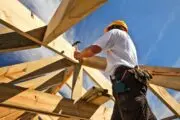
British Columbia has announced the kick off of a new mass timber construction plan that will fund housing projects across the province.
On April 7th, the B.C. government said it is launching its Mass Timber Action Plan and $1.2 million in funding for four new mass timber housing and infrastructure projects. The developments range from multi-family homes to mixed-use commercial and industrial buildings.
Mass timber consists of multiple layers of wood fastened together by glue, dowels or nails, and can be used in residential, commercial and industrial construction. According to the province, mass timber can match or exceed the performance of concrete and steel materials while reducing carbon emissions by as much as 45 per cent. Mass timber is also considered to be more economically valuable than milling logs for lumber.
The province’s Mass Timber Demonstration Program — which provides funding to support the design and construction of mass timber buildings — is run by Forestry Innovation Investment, and was established in spring 2021 with an initial $4.2 million investment.
The program’s four successful applicants for 2022 include a nine-storey, multi-family residential rental building at 1250 Granville Street in Vancouver, known as the Monad Granville Building. The structure will house 46 single bedroom and 15 two-bedroom units along with double-height commercial space on the lower levels. The high-rise, which will be the first prefabricated Passive House and mass timber mixed-use urban housing project in the city, is scheduled for completion in 2023.
The other three buildings that received funding include institutional and mixed-use commercial-industrial buildings in Vancouver and Castlegar.
Ravi Kahlon, B.C.’s Minister of Jobs, Economic Recovery and Innovation, announced the Mass Timber Action Plan this week while at the University of Victoria, where a 783-bed mass timber student housing and dining project is scheduled to open in September. The university is home to three mass timber projects, including an engineering and computer science expansion, and the National Centre for Indigenous Laws. Throughout the province, $575 million has been invested into seven different projects that involve mass timber at post-secondary institutions.
Monad Granville is the first of its kind. A prefabricated mass timber high-rise, mixed-use housing building, coming to @BrendaBaileyBC‘s community! pic.twitter.com/32SDcnx33R
— Ravi Kahlon (@KahlonRav) April 8, 2022
“Mass timber is a triple-word score. It allows us to reduce our carbon footprint from construction, it adds value to our forestry sector, and it provides new opportunities for jobs, growth and innovation in every corner of the province,” said Kahlon in a press release. “Positioning B.C. to be a global leader in mass-timber research, engineering innovation and production is a key action in the StrongerBC Economic Plan.”
Mass timber projects are one component of the StrongerBC Economic Plan, and aligns with B.C.’s climate goals through clean growth and the use of renewable resources. According to the province, B.C. could have up to 10 new mass timber manufacturers by 2035.
B.C. recently adopted new national provisions to allow for mass timber buildings up to 12 storeys high — 22 communities have adopted this standard. The province says that it leads North America with the most mass timber buildings per capita, with 285 projects completed or underway as of December 2020.
“Growing B.C.’s mass timber sector is a key part of our government’s vision for the future of forestry — a future where we get more value from every tree harvested,” said Katrine Conroy, B.C.’s Minister of Forests. “The Mass Timber Action Plan will help us transform the forestry industry and ensure workers and communities continue to benefit from secure, innovative jobs for generations to come.”






